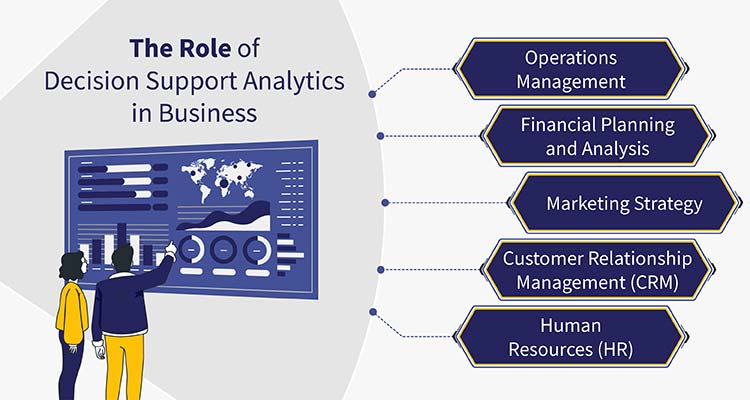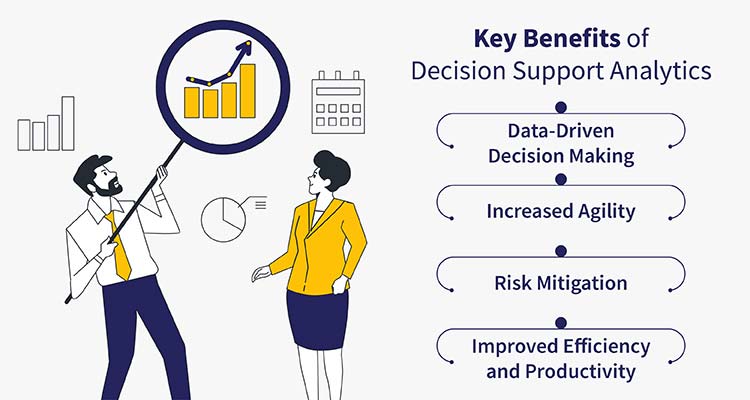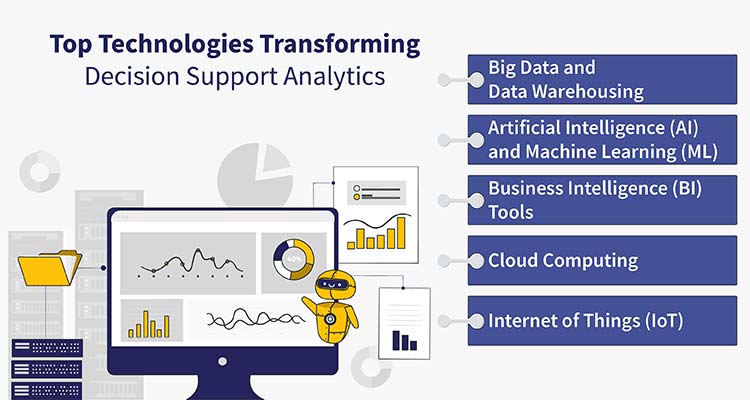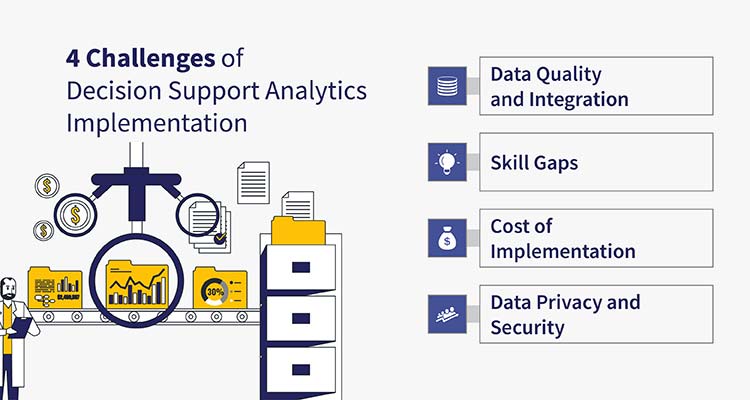Decision Support Analytics (DSA) empowers organizations to make data-driven decisions by leveraging advanced analytics tools and methodologies. DSA integrates descriptive, predictive, and prescriptive analytics, enabling businesses to assess scenarios, forecast outcomes, and strategize effectively. It enhances operations, financial planning, marketing, CRM, and HR processes, driving efficiency, agility, risk mitigation, and customer satisfaction.
Table of Contents
- What is Decision Support Analytics (DSA)
- What is Decision Support Systems (DSS) and it’s Types in Analytics?
- How Decision Support Analytics Drives Business Success
- 5 Benefits of Decision Support Analytics (DSA)
- Top 5 Key Technologies Enabling Decision Support Analytics (DSA)
- Challenges in Implementing Decision Support Analytics
- The Future of Decision Support Analytics
- Conclusion
In today’s data-driven world, organizations face the challenge of making accurate, timely decisions that can impact their growth, efficiency, and competitive edge. Decision Support Analytics (DSA) emerges as a powerful toolset designed to help businesses sift through large volumes of data, identify trends, generate actionable insights, and make informed decisions. This article delves into the core concepts of Decision Support Analytics, its applications, benefits, and how it is transforming the modern business landscape.
What is Decision Support Analytics (DSA)
Decision Support Analytics (DSA) refers to a combination of data analysis tools, technologies, and methodologies that help organizations make informed decisions based on data. At its core, DSA integrates various forms of data processing – such as descriptive, predictive, and prescriptive analytics – into a cohesive framework that allows decision-makers to assess multiple scenarios, forecast outcomes, and strategize accordingly.
Key Elements of Decision Support Analytics:
- Data Collection: Gathering data from various sources, including transactional systems, social media, IoT devices, and external databases.
- Data Processing and Analysis: Using analytics tools and algorithms to process, clean, and transform raw data into usable insights.
- Visualization and Reporting: Presenting complex data in an easy-to-understand format, often through dashboards, charts, and reports.
- Modeling and Simulation: Applying advanced techniques like machine learning and statistical modeling to predict future outcomes and recommend optimal solutions.
What is Decision Support Systems (DSS) and it’s Types in Analytics?
Decision Support Analytics (DSA) is part of a larger ecosystem known as Decision Support Systems (DSS), which have evolved over the past several decades. Decision Support Systems initially began as systems that supported managerial decision-making by providing relevant information from internal databases. These early systems focused mainly on structured data – like financial records and operational statistics – to provide decision-makers with straightforward reports and dashboards.
With the advent of big data, cloud computing, artificial intelligence (AI), and machine learning (ML), DSS has significantly transformed. Today, DSS incorporates unstructured data – such as social media feeds, customer reviews, and multimedia content and applies advanced analytics to provide not only descriptive but also predictive and prescriptive insights.
Types of Analytics in Decision Support Systems (DSS)
- Descriptive Analytics: Provides historical data analysis to understand what has happened.
- Predictive Analytics: Uses historical data and statistical models to forecast future trends.
- Prescriptive Analytics: Recommends specific actions based on predictive insights to achieve desired outcomes.
This shift from data reporting to data-driven decision-making highlights the growing importance of DSA in shaping business strategies.
How Decision Support Analytics Drives Business Success
Incorporating DSA into an organization’s decision-making processes can create value across multiple functional areas, from operations to marketing and beyond.

1. Operations Management
Organizations rely on operational efficiency to reduce costs and enhance productivity. DSA can monitor performance metrics, optimize supply chains, manage inventory, and predict potential disruptions. For example, in the manufacturing industry, predictive analytics can anticipate machinery failures, enabling proactive maintenance and minimizing downtime.
2. Financial Planning and Analysis
In finance, decision support analytics helps optimize cash flow management, risk assessment, and forecasting. It aids in portfolio management by analyzing market trends, customer behavior, and economic indicators to predict investment opportunities. This analytical approach to financial planning empowers CFOs and finance teams to make informed budgetary and investment decisions while mitigating risk.
3. Marketing Strategy
Marketing departments use DSA to analyze customer preferences, behavior patterns, and campaign performance. By employing predictive analytics, businesses can forecast consumer trends, personalize marketing strategies, and target specific demographics more effectively. Real-time marketing analytics also allow marketers to track the effectiveness of campaigns, optimizing them as they unfold.
4. Customer Relationship Management (CRM)
DSA plays a critical role in enhancing customer experience. By analyzing customer interactions, feedback, and purchase patterns, companies can better understand customer needs, preferences, and pain points. These insights help businesses build more personalized customer journeys, improve retention, and increase customer satisfaction.
5. Human Resources (HR)
HR teams use DSA for workforce analytics, predicting employee turnover, identifying skill gaps, and improving recruitment processes. Predictive analytics can forecast staffing needs based on historical data, allowing HR managers to plan for hiring and training more effectively. Additionally, prescriptive analytics can suggest strategies to enhance employee engagement and productivity.
5 Benefits of Decision Support Analytics (DSA)
The integration of Decision Support Analytics (DSA) into organizational decision-making offers several key benefits:

1. Data-Driven Decision Making
DSA enables businesses to base their decisions on data rather than intuition or guesswork. With access to real-time data and advanced analytical tools, decision-makers can evaluate various scenarios, understand the potential impact of their choices, and make informed decisions that align with business objectives.
2. Improved Efficiency and Productivity
By automating data collection, processing, and analysis, DSA reduces the manual effort required for decision-making. This automation leads to faster decision cycles and improved productivity, allowing teams to focus on more strategic tasks. Furthermore, data visualization tools present complex data in easy-to-digest formats, facilitating quicker understanding and action.
3. Increased Agility
In rapidly changing markets, the ability to adapt quickly is a critical competitive advantage. DSA provides businesses with the agility to respond to market changes, customer demands, or operational challenges in real-time. Predictive analytics helps forecast changes, while prescriptive analytics suggests optimal responses, enabling businesses to pivot their strategies as needed.
4. Risk Mitigation
Decision support analytics allows organizations to anticipate potential risks and challenges. By analyzing historical data, identifying trends, and predicting outcomes, businesses can take preventive measures before problems escalate. For instance, financial institutions use predictive analytics to detect fraud, while manufacturers use it to foresee supply chain disruptions.
5. Enhanced Customer Satisfaction
With customer analytics, businesses can gain a deeper understanding of their customers’ needs and preferences. By delivering personalized experiences and products, companies can build stronger relationships, foster brand loyalty, and improve customer retention.
Top 5 Key Technologies Enabling Decision Support Analytics (DSA)
Several technologies underpin the functionality and effectiveness of Decision Support Analytics (DSA). These technologies enable organizations to harness the power of big data, automate analytics processes, and generate actionable insights.

1. Big Data and Data Warehousing
Big data technologies allow organizations to store and process vast amounts of structured and unstructured data. Data warehousing solutions consolidate data from various sources into a centralized repository, making it easier to analyze and generate insights. Examples include cloud-based data platforms like Snowflake, Amazon Redshift, and Google BigQuery.
2. Artificial Intelligence (AI) and Machine Learning (ML)
AI and machine learning (ML) play a pivotal role in predictive and prescriptive analytics. Machine learning algorithms analyze historical data to identify patterns and predict future trends, while AI automates the decision-making process by recommending optimal actions based on these predictions.
3. Business Intelligence (BI) Tools
BI tools, such as Power BI, Tableau, and Qlik, allow organizations to create interactive dashboards and reports. These tools help visualize data and present it in a user-friendly manner, enabling decision-makers to explore and interpret data with ease.
4. Cloud Computing
Cloud platforms provide the scalability and computational power necessary to process large datasets and run complex analytics models. Cloud computing also facilitates real-time data access, enabling decision-makers to retrieve insights from anywhere, at any time.
5. Internet of Things (IoT)
IoT devices generate massive amounts of data from sensors, machines, and other connected devices. This data can be analyzed to provide real-time insights into operational performance, supply chain management, and customer interactions.
Challenges in Implementing Decision Support Analytics
While DSA offers numerous benefits, organizations face several challenges in implementing and scaling analytics solutions:

1. Data Quality and Integration
The effectiveness of DSA depends heavily on the quality and accuracy of the data being analyzed. Poor data quality, inconsistent formats, and data silos can lead to inaccurate insights. Ensuring data integration across multiple systems and departments is crucial for creating a reliable decision support system.
2. Skill Gaps
Implementing and managing advanced analytics solutions requires specialized skills in data science, machine learning, and statistics. Many organizations struggle to find or train professionals with the necessary expertise to build and maintain decision support systems.
3. Cost of Implementation
The infrastructure required for DSA – such as cloud computing, data warehousing, and AI technologies – can be costly to implement and maintain. Additionally, ongoing investments in technology upgrades and staff training are needed to keep the system current and effective.
4. Data Privacy and Security
With the increasing use of data for decision-making, organizations must ensure they comply with data privacy regulations (e.g., GDPR, CCPA) and implement robust security measures to protect sensitive information.
The Future of Decision Support Analytics
As businesses continue to generate and collect more data, the role of DSA will become even more critical. Several trends are shaping the future of decision support analytics, including:
AI-Driven Decision Support Systems
AI-powered decision support systems will become more prevalent, providing real-time recommendations and automating decision-making processes. These systems will continuously learn from new data, improving their accuracy and effectiveness over time.
Edge Analytics
With the growth of IoT, edge analytics will play a significant role in processing data closer to its source. By analyzing data at the edge of the network, businesses can make faster decisions without relying on centralized cloud systems.
Augmented Analytics
Augmented analytics, which combines AI with traditional BI tools, will further democratize data access. It will enable business users, even those without technical expertise, to perform sophisticated analyses and generate insights using natural language queries and automated data preparation.
Conclusion
Decision Support Analytics is reshaping the way businesses operate and make strategic decisions. By leveraging data, AI, and advanced analytics, organizations can improve efficiency, mitigate risks, and gain a competitive edge. As technology continues to evolve, the capabilities of DSA will expand, enabling even more intelligent and autonomous decision-making processes. For businesses looking to stay ahead in today’s fast-paced world, investing in DSA is no longer an option – it is a necessity.
Decision Support Analytics represents a crucial capability for modern organizations seeking to thrive in an increasingly complex and data-driven business environment. Success in implementing DSA requires a balanced approach that considers technical, organizational, and human factors. Organizations must stay current with evolving technologies and methodologies while maintaining focus on their core business objectives and user needs.
As organizations continue to generate and collect more data, the importance of effective Decision Support Analytics will only grow. Those that successfully implement and leverage these capabilities will be better positioned to make informed decisions, respond to changes in their business environment, and maintain competitive advantages in their respective markets.
← Back to Blog


